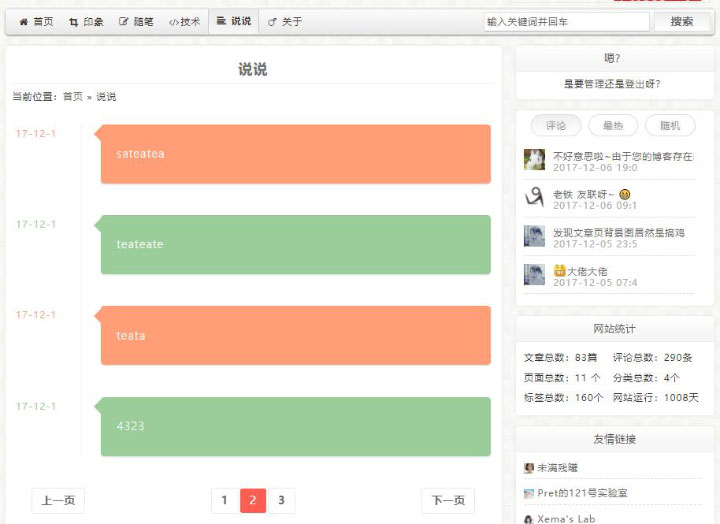半个月之前给博客添加了说说功能,缘由是在淘气’s Blog看到了一段漂亮的CSS说说代码,便想着拿过来用了。而仅写一个html页面太不方便了,每次添加新说说都需要重新编辑html代码。
还好,经过参考(拷贝)王柏元博客的这篇文章以及觉唯设计的《WordPress自定义文章类型的分页列表调用问题》一文,最终东拼西凑完成了这个能够在wordpress后台发表说说的玩意儿。
因本博遵循的CC BY-SY-NC 要求“相同方式共享”,与上一篇文章一样,我把这些内容发表在这里。
原理及需求
wordpress内容的发表除了页面就是文章,因此我们发表说说也跳不出这两个东西。说说对象的结构一致,因此采用自定义文章类型的形式来保存每一条说说。显示说说就很简单了,在一个页面中写查找方法,把自定义文章类型下的所有文章按格式打印即可。当然,由于说说文章数量可能过多,因此理应实现翻页功能。总结,我的需求有三个:1、后台发表说说;2、显示说说;3、说说内容分页
开始添加
1.注册自定义文章类型
这些代码不难理解,无需解释。将其拷贝到主题的funcion.php即可。
//转载自王柏元的博客
//http://wangbaiyuan.cn
//注册说说类型文章
add_action('init', 'my_custom_init');
function my_custom_init()
{ $labels = array( 'name' => '说说',
'singular_name' => '说说',
'add_new' => '发表说说',
'add_new_item' => '发表说说',
'edit_item' => '编辑说说',
'new_item' => '新说说',
'view_item' => '查看说说',
'search_items' => '搜索说说',
'not_found' => '暂无说说',
'not_found_in_trash' => '没有已遗弃的说说',
'parent_item_colon' => '', 'menu_name' => '说说' );
$args = array( 'labels' => $labels,
'public' => true,
'publicly_queryable' => true,
'show_ui' => true,
'show_in_menu' => true,
'exclude_from_search' =>true,
'query_var' => true,
'rewrite' => true, 'capability_type' => 'post',
'has_archive' => false, 'hierarchical' => false,
'menu_position' => null, 'supports' => array('editor','author','title', 'custom-fields') );
register_post_type('shuoshuo',$args);
}
//结束如果得法,你已经可以在wp后台见到说说发表与控制。
2.添加说说页面模板
因我们需要在页面中打印说说列表,因此创建一个页面模板。页面模板的创建方法很简单,只要在页面前声明Template Name: XX 即可。
为了能够与主题样式一致,因此可以复制一份主题目录下的page.php,观察其结构,一般都为get_header开始,get_footer结束。二者中间会有一个主div容器,例如
<div class=”content”>,其内你可以找到查询与打印页面内容对应的php代码。而根据其结构可知,我们需要修改的是页面内容PHP代码。
好了,思路就是1、声明页面模板;2、修改内容查询代码。
假设你已经复制了一份page.php并将其命名为其他名称,例如page-shuoshuo.php。
2.1声明页面模板
我将其写在了PHP首行。
<?php /*
Template Name: 说说
author: yetu
url: http://www.azimiao.com
*/
get_header(); ?>
2.2修改内容查询代码
我们自定义一个查询来查询对应文章,并将其打印即可。这里拷贝了淘气博客的说说CSS样式,并参考了味觉设计的自定义查询与分页代码。
<div class="content">
<link rel="stylesheet" href="//css.azimiao.com/shuoshuo.css" type="text/css">
<div id="article">
<h1><a href="<?php the_permalink() ?>" rel="bookmark"><?php the_title();
?></a></h1>
<div class="position">当前位置:<a href="<?php echo get_option('home'); ?>/">首页</a> »
说说</div>
<div id="article_content">
<ul class="cbp_tmtimeline">
<?php
$temp = $wp_query;
$wp_query = null;
$wp_query = new WP_Query();
$show_posts = 4;//每页显示的页数
$permalink = 'Post name';// Default, Post name
$post_type = 'shuoshuo';//Know the current URI
$req_uri = $_SERVER['REQUEST_URI'];//Permalink set to default
if ($permalink == 'Default') {
$req_uri = explode('paged=', $req_uri);
if ($_GET['paged']) {
$uri = $req_uri[0] . 'paged=';
} else {
$uri = $req_uri[0] . '&paged=';
}
//Permalink is set to Post name
} elseif ($permalink == 'Post name') {
if (strpos($req_uri, 'page/') !== false) {
$req_uri = explode('page/', $req_uri);
$req_uri = $req_uri[0];
}
$uri = $req_uri . 'page/';
}
//Query
//echo 'showposts='.$show_posts.'&post_type='. $post_type .'&paged='.$paged;
$wp_query->query('showposts=' . $show_posts . '&post_type=' . $post_type . '&paged=' . $paged);
//count posts in the custom post type
$count_posts = wp_count_posts('projects');
while ($wp_query->have_posts()):
$wp_query->the_post();
?>
<li>
<time class="cbp_tmtime">
<span><?php the_time('y-n-j');
?></span>
</time>
<div class="cbp_tmlabel">
<p><?php the_content();
?></p>
</div>
</li>
<?php endwhile;
?>
</ul>
</div>
<?php comments_template();
?>
</div>
</div>2.3实现分页
上述代码已经实现了分页核心功能。按照代码中给定的查询参数,其只会打印出规定条数的说说,且不同页数用/page/2类型url进行翻页。但由于此时还没有写翻页按钮,即没有页码导航及对应按钮,因此不能显式翻页。
在上文文章模板所需位置,添加翻页区域div容器。本人添加在了</ul>后。
<!-- 分页 -->
<div class="pagination">
<?php by_pagenavi(); ?>
</div>分页导航显示方法及对应的css样式,转载自王柏元的博客,将其放置在合适的位置即可。
//分页导航显示方法
//转载自王柏元博客
//http://wangbaiyuan.cn
<?php
function by_pagenavi($before = '', $after = '', $p = 2) {
if (is_singular()) return;
global $wp_query, $paged;
$max_page = $wp_query->max_num_pages;
if ($max_page == 1) return;
if (empty($paged)) $paged = 1;
echo $before;
if ($paged > 1) by_p_link($paged - 1, '上一页', '<span class="pg-item pg-nav-item pg-prev">', '上一页');
if ($paged > $p + 1) by_p_link(1, '首页', '<span class="pg-item">', 1);
for ($i = $paged - $p;$i <= $paged + $p;$i++) {
if ($i > 0 && $i <= $max_page) $i == $paged ? print "<span class='pg-item pg-item-current'><span class='current'>{$i}</span></span>" : by_p_link($i, '', '<span class="pg-item">', $i);
}
if ($paged < $max_page - $p) by_p_link($max_page, '末页', '<span class="pg-item"> ... </span><span class="pg-item">', $max_page);
if ($paged < $max_page) by_p_link($paged + 1, '下一页', '<span class="pg-item pg-nav-item pg-next">', '下一页');
echo $after;
}
function by_p_link($i, $title = '', $linktype = '', $prevnext = '') {
if ($title == '') $title = "浏览第{$i}页";
if ($linktype == '') {
$linktext = $i;
} else {
$linktext = $linktype;
}
echo "{$linktext}<a style = 'border-bottom:1px solid #eaeaea !important;' href='", esc_html(get_pagenum_link($i)), "' title='{$title}' class='navbutton'>{$prevnext}</a></span>";
}
?>
/*
分页导航样式
转载自王柏元博客
http://wangbaiyuan.cn
*/
div.pagination {
padding: 0px;
margin: 25px 0 40px;
text-align: center;
font-size: 15px;
line-height: 17px;
position: relative;
}
.pagination .pg-filler-1 {
width: 35%;
}
.pagination .pg-filler-2 {
width: 40%;
}
.pagination .pg-item a, .pagination .pg-item .current,.pagination .pg-dots, .pagination .pg-item .disabled {
display: inline-block;
color: #666;
padding: 9px 13px;
border-radius: 3px;
-webkit-border-radius: 3px;
-moz-border-radius: 3px;
text-decoration: none;
margin: 0 1px;
min-width: 10px;
}
.pagination .pg-item a {
-webkit-transition: background .2s linear;
-moz-transition: background .2s linear;
-ms-transition: background .2s linear;
-o-transition: background .2s linear;
transition: background .2s linear;
-webkit-backface-visibility: hidden;
-moz-backface-visibility: hidden;
}
.pagination .pg-next {
position: absolute;
right: 20px;
}
.pagination .pg-prev {
position: absolute;
left: 20px;
}
.pg-nav-item {
text-transform: uppercase;
}
.pagination .pg-item .current, .pagination .pg-item a:hover {
background: #FF5E52;
color: #fff;
}
div.pagination span.current, div.pagination a {
padding: 0px;
text-decoration: none;
}
div.pagination a.navbutton {
margin: 0 2px;
border: 1px solid #eaeaea;
}使用方法及效果
后台发表一个页面,页面模板选择说说,页面链接不要设为shuoshuo,页面链接不要设为shuoshuo,页面链接不要设为说说,不然你的分页可能会出现404哦~如果页面链接与注册文章类型冲突,可能会有意想不到的问题出现哦~。
后台发表几条说说,访问上面的页面看看效果吧~

友情提醒
想要修改输出内容的话也非常简单哦,如添加点击说说跳转到说说详情,只需要在查询时把链接拿出来,给单条说说套一个a标签就好啦!
引用资料
1、[内容]【王柏元的博客】王柏元 在wordpress上写说说/短微博
2、[内容]【淘气’s Blog】淘气’s Blog 抄了个说说页面
3、[内容]【觉唯设计】觉唯设计 WordPress自定义文章类型的分页列表调用问题






